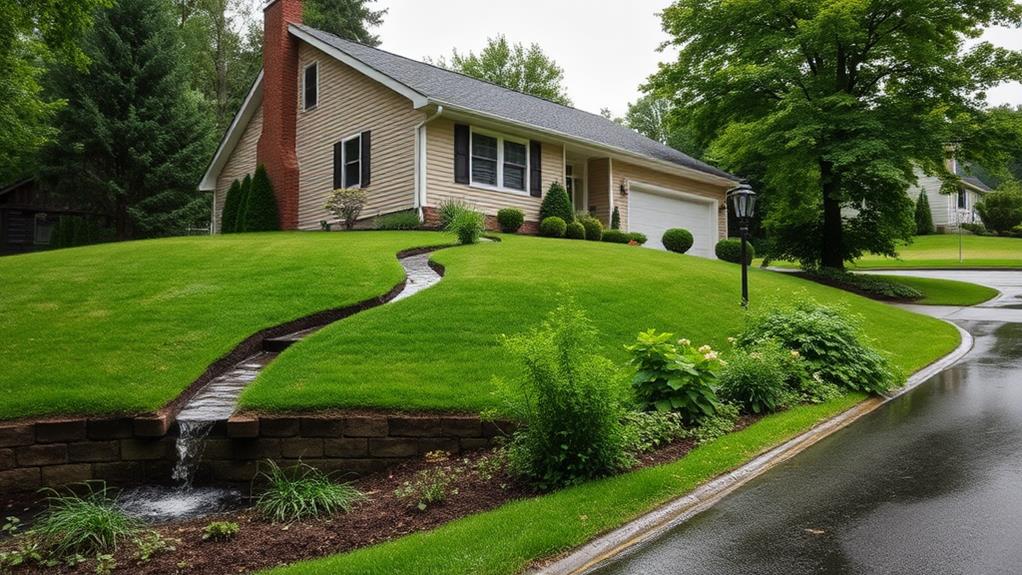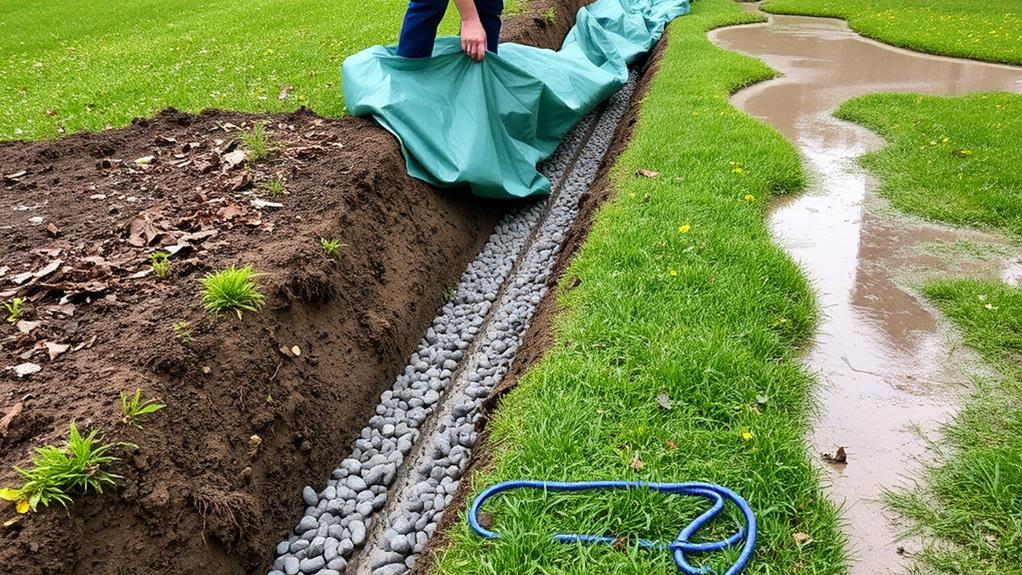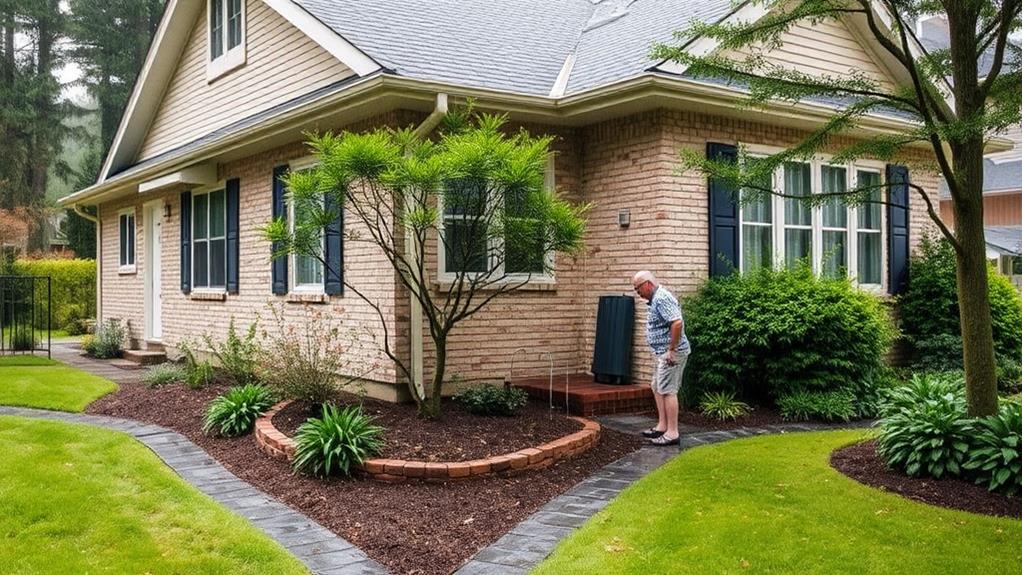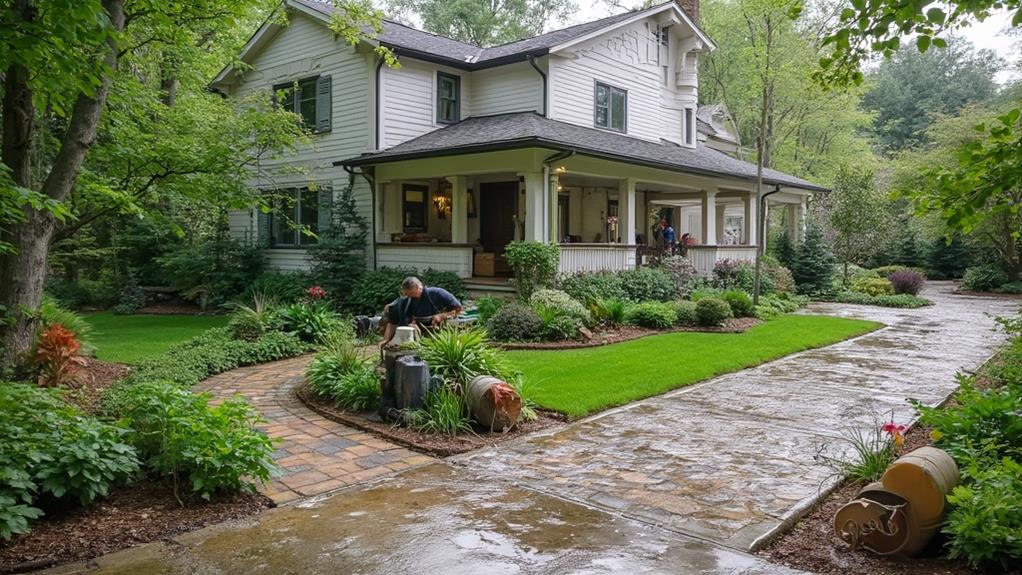To protect your home from standing water after heavy rains, focus on proper grading and sloping, ensuring a gentle decline away from your foundation. Install effective gutter systems with appropriate capacity and downspout extensions. Consider implementing French drains to redirect water away from problem areas. Incorporate permeable landscaping solutions like porous pavers and rain gardens to absorb excess runoff. Regular maintenance is crucial: clean gutters, inspect roofing, and check drainage systems periodically. By combining these strategies, you can significantly reduce the risk of water accumulation around your property. Explore these methods further to create a comprehensive water management plan for your home.
Proper Grading and Sloping

Two key elements of preventing standing water are proper grading and sloping of the landscape. These techniques ensure that water flows away from your home's foundation and other structures, reducing the risk of water damage and potential flooding.
Proper grading involves creating a gentle slope that directs water away from buildings. Ideally, the ground should drop at least 6 inches over a distance of 10 feet from the foundation. This gradient allows rainwater to naturally flow towards designated drainage areas or storm sewers.
Sloping is crucial for areas prone to water accumulation. Identify low spots in your yard and gradually build them up to create a consistent slope. Use fill dirt or topsoil to raise these areas, ensuring a smooth transition to existing grades.
When implementing grading and sloping, consider the natural contours of your property and local drainage patterns. Avoid directing water towards neighboring properties or public spaces. Instead, guide it to appropriate drainage systems or rain gardens.
Regular maintenance is essential to preserve proper grading and sloping. Monitor for erosion, settling, or changes in landscape that may affect water flow, and address issues promptly to maintain effective drainage.
Effective Gutter Systems
Complementing proper grading and sloping, effective gutter systems play a crucial role in preventing standing water around your property. These systems collect rainwater from your roof and direct it away from your home's foundation, reducing the risk of water accumulation and potential damage.
To ensure optimal performance, install gutters with the appropriate size and capacity for your roof area and local rainfall patterns. Seamless gutters are preferred as they minimize leaks and clogs. Position downspouts strategically to discharge water at least 5-10 feet away from your home's foundation. Consider using downspout extensions or underground drainage pipes for improved water dispersion.
Regular maintenance is essential for gutter efficiency. Clean gutters at least twice a year, removing debris that can cause blockages. Install gutter guards to reduce debris accumulation and maintenance frequency. Check for proper slope and alignment, ensuring water flows freely towards downspouts. Repair any leaks, loose fasteners, or damaged sections promptly.
In areas with heavy rainfall, consider installing larger gutters or adding more downspouts to handle increased water volume. For homes with complex roof designs, consult a professional to design a custom gutter system that addresses all potential problem areas.
Install French Drains

While effective gutter systems manage water from roofs, French drains offer a solution for ground-level water issues. These subsurface drainage systems consist of perforated pipes surrounded by gravel, which collect and redirect excess water away from problem areas.
To install a French drain, begin by planning the route and ensuring a proper slope for water flow. Excavate a trench along the planned path, typically 18-24 inches deep and 12 inches wide. Line the trench with landscape fabric to prevent soil infiltration. Place a layer of gravel at the bottom, then position the perforated pipe with its holes facing downward. Cover the pipe with more gravel, leaving about 5 inches of space from the surface.
Wrap the landscape fabric over the gravel and backfill the trench with soil. The drain should terminate at a suitable outlet, such as a storm sewer, dry well, or a lower area of your property. Regular maintenance, including periodic cleaning and inspection, ensures optimal performance.
French drains effectively manage excess groundwater, preventing standing water issues and potential foundation damage. When combined with proper gutters and grading, they form a comprehensive water management system for your property.
Permeable Landscaping Solutions
Permeable landscaping solutions offer an innovative approach to managing surface water runoff. These environmentally friendly designs allow water to penetrate the ground naturally, reducing the risk of standing water and its associated problems. By incorporating porous materials into your landscape, you can effectively mitigate water accumulation while maintaining an attractive outdoor space.
One popular option is permeable pavers, which are specially designed interlocking stones with gaps that allow water to seep through. These can be used for driveways, patios, and walkways. Another solution is porous asphalt or concrete, which contains larger aggregates to create void spaces for water drainage. For garden areas, consider using gravel or crushed stone pathways instead of solid surfaces.
Rain gardens are another effective permeable landscaping feature. These shallow depressions filled with native plants and absorbent soil help filter and absorb excess water. Additionally, bioswales – landscaped channels designed to concentrate and convey stormwater runoff – can be incorporated into larger properties to manage water flow effectively.
When implementing permeable landscaping solutions, it's crucial to consider proper installation and maintenance to ensure long-term effectiveness in preventing standing water issues.
Regular Maintenance and Inspection

Regular maintenance and inspection play a crucial role in preventing standing water issues on your property. Implementing a proactive approach to maintenance can help identify and address potential problems before they escalate.
Start by regularly cleaning gutters and downspouts to ensure proper water flow away from your home's foundation. Inspect your roof for damaged or missing shingles that could lead to leaks and water accumulation.
Check your property's grading periodically, especially after heavy rains or snowmelt, to ensure the ground slopes away from your home. Look for areas where soil may have settled or eroded, creating low spots that collect water. Regularly test your sump pump to ensure it's functioning correctly and can handle excess water during heavy rainfall.
Inspect outdoor drains, catch basins, and French drains for clogs or damage. Clear away debris and vegetation that may obstruct water flow. Pay attention to areas prone to standing water and monitor them closely after rain events. Consider professional inspections of your property's drainage systems every few years to identify potential issues that may not be immediately apparent. By maintaining a consistent inspection and maintenance routine, you can significantly reduce the risk of standing water problems on your property.
Frequently Asked Questions
How Can I Identify Potential Water Accumulation Spots Before Heavy Rainfall?
To identify potential water accumulation spots, inspect your property's low-lying areas, check for poor drainage around foundations, examine gutters and downspouts, assess soil compaction, and look for depressions in your lawn or driveway.
What Are the Health Risks Associated With Standing Water Around Homes?
Standing water around homes poses significant health risks, including:
- Mosquito breeding grounds, increasing disease transmission
- Growth of harmful bacteria and pathogens
- Mold and mildew proliferation
- Contamination of nearby water sources
- Attraction of pests and rodents
Can Indoor Humidity Levels Indicate Outdoor Water Drainage Issues?
Like a canary in a coal mine, indoor humidity can signal outdoor drainage problems. Elevated indoor humidity levels may indicate water pooling around your home's foundation, potentially leading to structural issues and mold growth if left unaddressed.
Are There Any Government Programs That Assist With Water Management Improvements?
Several government programs assist with water management improvements. The EPA's Clean Water State Revolving Fund, FEMA's Hazard Mitigation Grant Program, and USDA's Rural Development Water and Environmental Programs offer financial support for various water-related projects and infrastructure upgrades.
How Do Different Soil Types Affect Water Drainage and Standing Water Prevention?
Like a sieve's varying mesh sizes, different soil types affect water drainage distinctly. Sandy soils drain quickly, while clay soils retain water. Loamy soils offer a balanced approach, providing adequate drainage while retaining some moisture for plant growth.
Conclusion
Mitigating standing water after heavy rains requires a multifaceted approach. Proper grading, effective gutters, French drains, and permeable landscaping form the bedrock of a comprehensive water management strategy. Regular maintenance and inspections are crucial to ensuring these systems function optimally. By implementing these measures, homeowners can create a robust defense against water accumulation, safeguarding their property from potential damage. Like a well-oiled machine, a properly maintained drainage system keeps homes high and dry, even in the face of torrential downpours.

